

The original Dunaskin brickworks was situated in Dunaskin Glen at Waterside, Ayrshire. The brickworks was built in the 1850's by the Dalmellington Iron Company to serve the ironworks at Waterside. The Dalmellington Iron Company was founded in 1848 by Henry Houldsworth, a Glasgow cotton mill owner. The company owned the ironworks at Waterside and operated a number of mines in the surrounding area. The brickworks manufactured firebricks for lining the furnace and for building the ancillary buildings, such as the workshop range, needed to service the ironworks. The brickworks in Dunaskin Glen closed in 1928 and was resited on the ground where the furnaces used to stand. The bricks were stamped DICO, standing for Dalmellington Iron Company. The ironworks closed in 1921 but the company continued to operate their mines until 1930 when bankruptcy caused the company to fold. In 1931 the brickworks was taken over by William Baird and a new company formed, Baird and Dalmellington Ltd. The Brickworks featured a Staffordshire transverse arch kiln that had 14 connected chambers which were heated to 1,100-1,200'C by an under-floor heating system. The draught from the chimney drew heat through each chamber and up to 16,000 bricks were fired for two weeks in each chamber. In 1947 the brickworks came under the ownership of the Scottish Brick Company after nationalisation of the industry. The brickworks closed in 1976. A stained glass window, dating from the 1850s,that hung in the registered offices of the Dalmellington Iron Company was in the now defunct visitor centre at Dunaskin. Information taken from the scran database.


Photo by David Kitching.

Found on the seashore in Ballantrae, Ayrshire by Christine.
Dalquharran Brick & Tile Works was adjacent to the Romilly
Colliery site at Wallacetown in the Parish of Dailly in Ayrshire.
The works is believed to have
operated from c1859 to c1915. Info by David Kitching.

Martin Briscoe found this one on the beach at Portencross, Ayrshire

Found on the seashore in Ballantrae, Ayrshire by Christine.



Martin Briscoe photographed these three in Fort William

Found by Martin near Kilvickeon Old Churchyard on the Isle of Mull
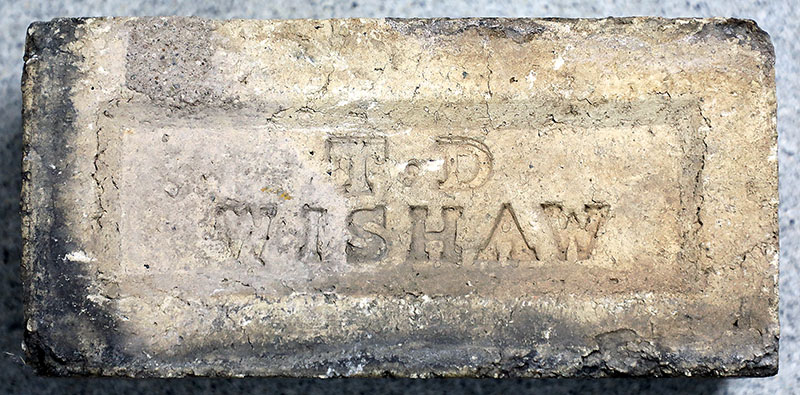
Thomas Dean, brickmaker, Beltonfoot Cottage, Wishaw, Motherwell. Photo by David Kitching.
Drumpark Brickworks, Bargeddie, Glasgow, Lanarkshire.

Found on the seashore at Prestonpans, East Lothian.

Found on a different seashore, this time by Ian Sinclair in Renfrewshire.


Joseph Hodgkiss found these two examples near Killin, Stirlingshire.

Photo by Alan Murray Rust.

Photo by Jason Sutcliffe.

Photo by Guy Morgan.

Found in Dundee. Photo by Brian Whyte.

Spotted by Peter Robinson near Moffat, Dumfriesshire.


A Scottish firebrick, found at a Spondon reclamation yard by
Martyn Fretwell.


Photos by Frank Lawson.

Photo by Ian Suddaby.

Found at the site of RAF Oban at Kerrara by Martin Briscoe, made in West Lothian

Found on waste ground in Edinburgh by Joseph Hodgkiss


Photo by Tony Gray.

Photo by Martin Briscoe, Messrs J Dougall & Sons, (Bonnyside Fireclay Works), Bonnyside Brickworks, High Bonnybridge 1896 - 1967.



Photos by Frank Lawson.

Sent in by Vladimir who found it in Kaliningrad, Russia.

Photo by George Simpson.


Photos by Ian Suddaby.


Simon Ratty writes: This is probably made by the Douglas Firebrick Co Ltd of Dalry Ayrshire which was operational by 1917 and believed to have closed in September 1945. The works apparently used clay from the nearby Monkcastle Fireclay Mine. From what I can can gather there's a number of remains surviving on the site and the Royal Commission on Ancient Historic Monuments of Scotland does have a series of photos. A number of these were found during excavation work at Ystalyfera Iron Works in South Wales. Photos by Martin Fretwell.

Photo by Tony Gray.

Photo by Charles Hindmarsh.

Photo by David KItching.

Found in a reclamation yard near Towcester by Nigel Furniss

Thanks to Mark Cranston for pointing out this reference:
"The VIIth International Ceramic congress was held in Britain in 1960, and on 24th May the members visited the Douglas Works at Dalry. A small descriptive booklet was issued for the occasion describing the various Douglas firebrick brands, and the high alumina Triangle brands based on calcined bauxite from Guyana, and the local bauxitic fireclays from high Smith-stone mine, and the Langside mine at Galston. The bauxitic clays were calcined in a shaft kiln with a capacity of about 3,000 tons a year, while firebricks amounted to about 25,000 tons a year. A most profitable range of refractory cements and castables added another 7,000 tons a year".
Photo by Frank Lawson collection.

Photo by Ian Suddaby/ This brick was found at Manuel where it was probably probably made in the 1960s or 70s.

Found by Martin Briscoe on the beach at Portencross, Ayrshire

Photo by Mark Cranston.


.jpg)
The Shieldmains Collieries are the likely source of this brick. Photo and information by David Kitching.


Fordell Mains Colliery Company, Brucefield Brickworks 1924 - 1960s at Brucefield Colliery. At nationalisation the brickworks passed to NCB. Photo and information by David Kitching.


Dykehead Firebrick Works, Bonnybridge, Stirlingshire. GR = General Refractories. Photos by Mark Cranston.
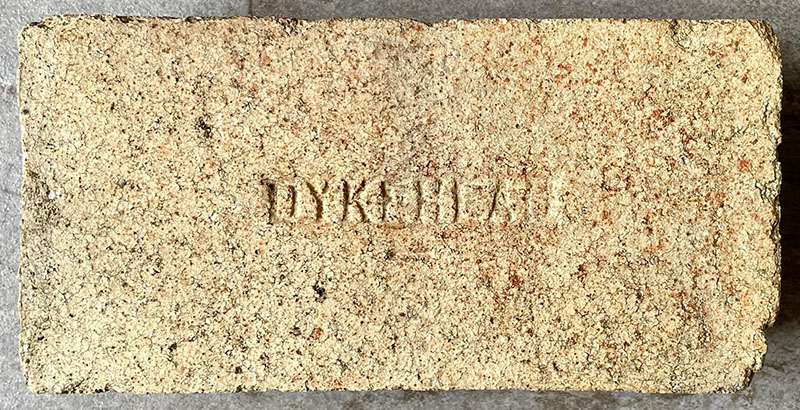
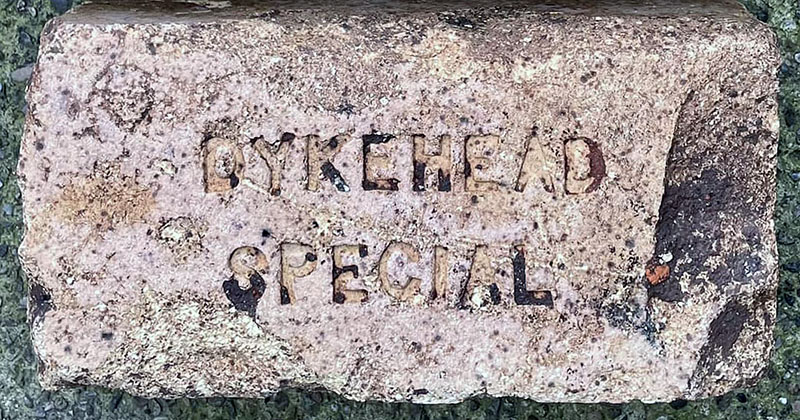
Photos by Phil Burgoyne.
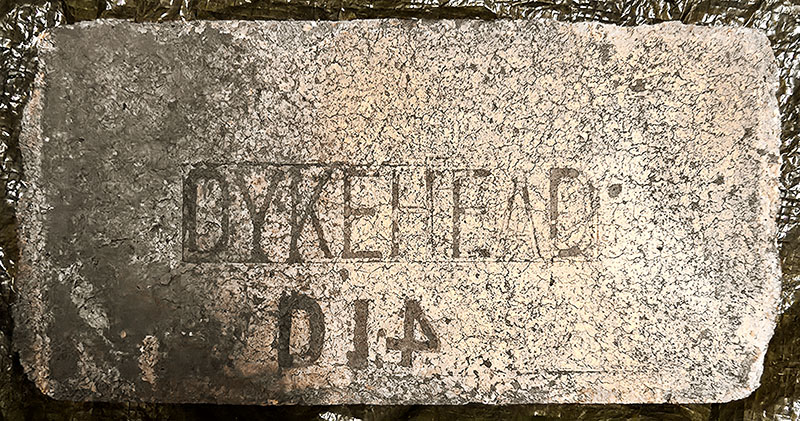
Photo by Liz Robinson.

Probably made by the Edinburgh Collieries Company


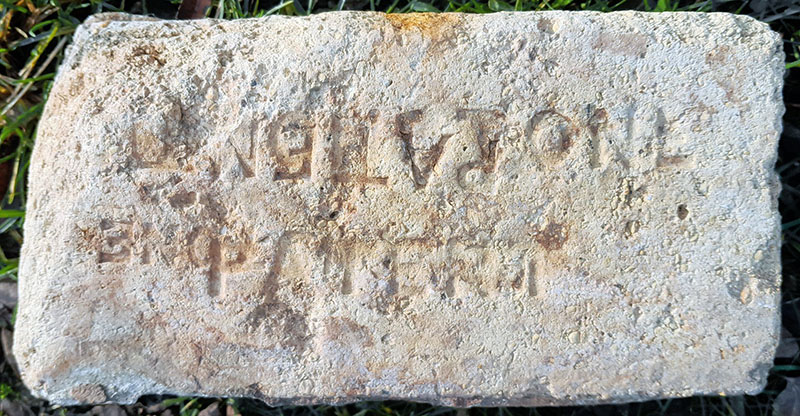
.jpg)
Eglinton Silica Brick Co. Ltd. produced firebricks from the 1860s at Dundyvan Silica Brick Works near Coatbridge. Photo and information by David Kitching.

Unearthed by Lee Robinson while demolishing a wash house in West
Kilbride.

Photo by Ian Suddaby.

The Scottish Brick History website suggests that this may be a product of James Dougall & Sons, Bonnybridge. This one was found on the shoreline between Llanelli and Burry Port by Hugh Owen

A well worn example found on Llanelli beach by Simon Phillips.

Photo by Ian Suddaby.

Found at a recycling centre in Edinburgh. Thanks to Joseph Hodgkiss for the contribution. Faskine Brickworks, Coatbridge, 1899 - 1911.

Hamilton Brickworks, 1936 - 1950. Photo by Mark Cranston.
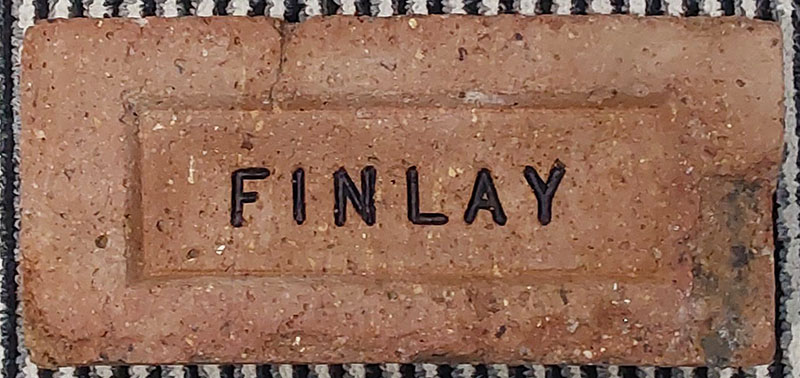
Photo by Bill Duff.

Another found by Martin Briscoe on the foreshore at Fort William. Gateside Brickworks, Cambuslang, 1899 - 1947.


Made at Roughcastle Firebrick Works, Bonnybridge. Photo by Chris Tilney.

Found by Robert Runyard at the old freezer plant in Puerto Bories in southern Chile.



Found on a Renfrewshire seashore by Ian Sinclair. Eric Flack writes: "FRANKFIELD" bricks were made in Carntyne in Glasgow. I Used to watch them coming out the kilns. I think the works closed in the 1970s. They made traditional Scottish bricks from colliery waste: black shale.


Found on a Renfrewshire seashore by Ian Sinclair. Alex Frew & Co operated two brickworks to the east of Airdrie in Lanarkshire. Rawyards Brick Works commenced working in the late 19th century, whilst the Drumbathie Brickworks to the south of Rawyards was in production from the early 20th century. Production at this latter works ceased c1960. Info by Tarboat

Found in the River Bonny at Bonnybridge, Scotland. Photo by Ian Suddaby.


Photo by Ian Suddaby.


Found in Chile by Juan Valdivia.

Found in Puerto Bories, Southern Chile by Robert Runyard.


Photographed at Hirum Walkers Distillery, Dumbarton by Ian
Sinclair. Garrowhill works, Glasgow, ca 1928 - ca 1945.


Photo and information by David Kitching.




Thanks to the Gartcosh Local History Group for these contributions. Gartcosh is about two miles from where the Glenboig and Heathfield brickworks were sited. There were also brickworks called Gartcosh Fire Clay Works nearby, open from 1863-1950.

Gartcraig Fire Clay Works, By Millerston, Glasgow. Works open 1876 - 1918. Photo by Jason Sutcliffe.

Found on a Renfrewshire seashore by Ian Sinclair.

Photographed at Summerlee Museum.

Photographed at Sunbury Plantation House in Barbados by Paul Davies.

Found in Chile. Photo by Juan Valdivia.

Photo by Mark Cranston.

Thought to be a trade name for some bricks produced at Gartcraig brickworks. Photo by Mike Graham.

Photographed at Hirum Walkers Distillery, Dumbarton by Ian Sinclair. Gartshore Brickworks, Kilsyth, 1934 - 1981.

Found by Martin Briscoe in Glenfinnan.

Part of the Summerlee collection, photo by Monkland Memories.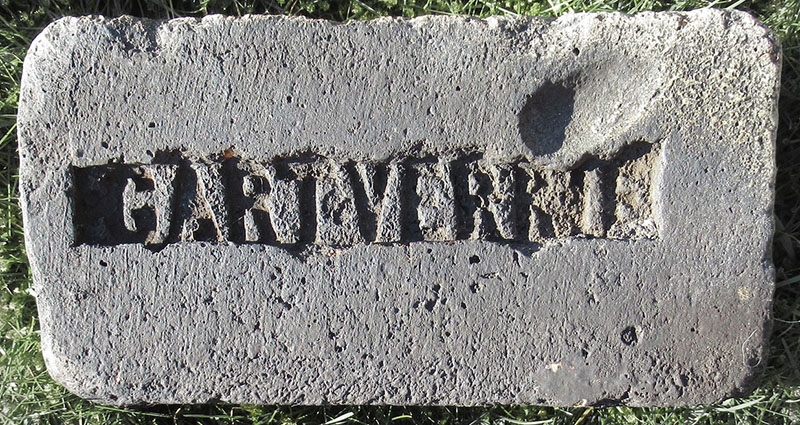
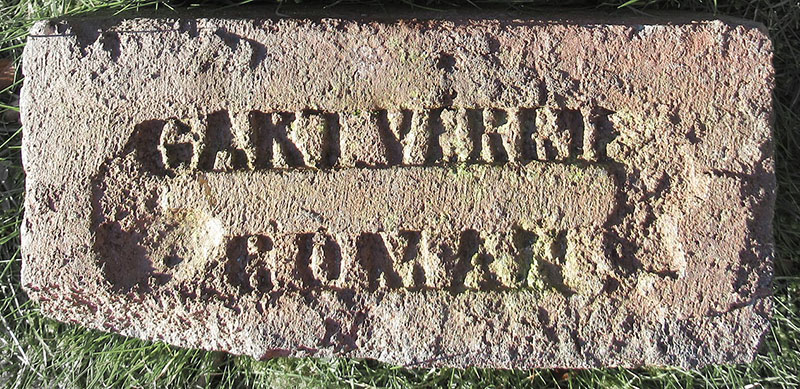

Gartverrie Fireclay Works, Glenboig. Photos by Ian Suddaby.

Photo by Mark Cranston.


Photo by Phil Jenkins.

Made in Motherwell, 1893 - 1915.

Gilbertfield colliery and brickworks, Cambuslang, Lanarks. Owned
by the
Cambuslang Coal Company. Photo and information by David Kitching.
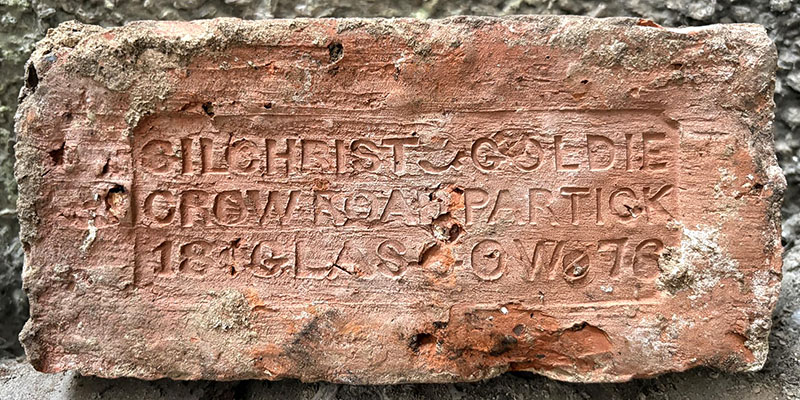
Gilchrist & Goldie, Crow Road, 18 Glasgow 76. Made at the Woodend Brickworks. Works open 1863 - 1883. Photo by Tom Moffat.

Old Langside Road, 18 Glasgow 82. Photographed at Summerlee Museum.

Gilchrist & Goldie, Langside Road, Glasgow. The Post Office Glasgow Directory 1882 lists: - "Gilchrist & Goldie, brickmakers, 40 St. Enoch Sq. ; brickfields, Butterbiggins, head of Eglinton St. ; Shawfield toll, Rutherglen Road ; Crow Rd., Partick." Info from Frank Lawson, photo by David Kitching.

Found on the seashore in Crosby, Merseyside. Bonnyton Fireclay Works, 1876 - 1899.

David Kitching writes: Giscol (registered as a company in 1888) was the trading name of the Glasgow Iron & Steel Company Limited an iron and steel producer with foundries and iron works situated in West Central Scotland. Today the name is used by Caradale Traditional Brick Ltd after a management buyout of the company in 1997. Today the company has two brickworks - the Etna works at Armadale, West Lothian and the Mayfield works at Carluke, Lanarkshire. Caradale is unique in the traditional brick making sector in that it uses shale clays. They're more difficult to work but they make a harder, more durable brick suitable for the extremes of British weather. Some photos of the works are here. Photo by Frank Lawson.

The Etna works was at Bathville near Armadale in West Lothian. It was one of the largest common-brick works in Scotland, making stiff-clay bricks from blaes (hardened clay or shale). There were four Hoffman continuous kilns here, two of c1897, with rounded ends and central chimneys. The two oldest kilns were out of use by the mid 1980s and have since been demolished. Information taken from the scran database. Photo by Don Boldison.

Photo by Mark Howard.

Photo by David Kitching.

Found on waste ground in Edinburgh by Joseph Hodgkiss

Photo by David Kitching.

Photo by Frank Lawson.


Photo by Dave Orr who writes: The brickworks were to the north of the present village. They also produced tiles and some examples can be seen in the Glamis Folk Museum in the village
There is an excellent film of this works in operation here

Found in an 1880's house in Manchester by John T Pitman


Both found on a Renfrewshire seashore by Ian Sinclair. The bottom one reads Starworks Glenboig. Robert Murray adds: The Glenboig Union Fireclay Co. had two brickworks in the village, the 'Old Works' and 'The Star Works'. The former closed in 1964 and the latter circa. 1974.

The J.D. stands for the brickworks owner, James Dunnachie. Info by Martyn Fretwell, photo by Frank Lawson.

Found at Stoke Bruerne near Towcester, Northants by Nigel Furniss.

Photo by David Kitching.

Photo by Ian Williams.

Photo by courtesy of the Richard Symonds collection.

Photo by Juan Valdivia.

Photo by Tony Gray.

Photo by Mark Howard.

Photo by Charlotte Buckley who spotted it at a tip in Broxburn, West
Lothian.





Photos by courtesy of the Frank Lawson collection.

Photographed at Sunbury Plantation House in Barbados by Paul Davies.

One made for the London and North Eastern Railway. Photo by Ian Suddaby.



Part of the Summerlee collection, photo by David Kitching.

Grangemouth fire brick works, situated behind the village of Skinflats alongside Grangemouth Colliery, Zetland Pit No.1, and linked to Carron Iron Works by a waggonway. The works was operating before 1866. 1912 saw the closure of Grangemouth Pits and the Brick Works. Information by David Kitching, photo by Alam Fleming.

Part of the Summerlee collection, photo by Monkland Memories.
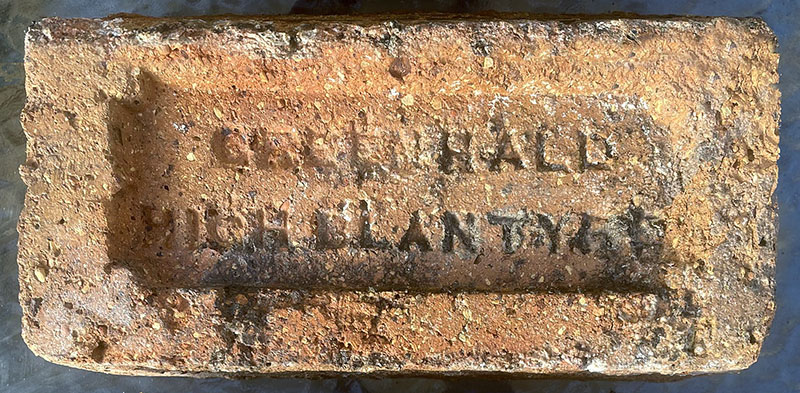
Greenhall Brickworks, High Blanytre, South Lanarkshire. Photo by Mike Sampaio.

Made at Greenhill Colliery, Cleland near Motherwell, 1873 - 1914. Photo by Phil Jenkins.

Found on waste ground in Edinburgh by Joseph Hodgkiss.

Photo by Mark Cranston.

John Grieve, Bankpark, Tranent. This is thought to date from 1849-1865. Photo by Ian Suddaby.
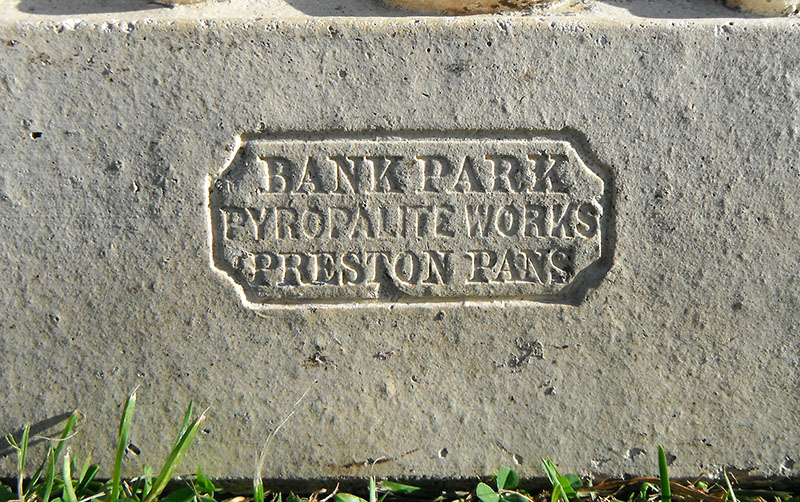
This was made by John Grieve at Bank Park Pyropalite Works which was at Tranent, East Lothian, Scotland. The Bank Park Pottery and Fireclay Works was open from the late 1840s until 1893 and it seems like the name Pyropalite Works was only used in the very early days, later on it was Fire Clay Works. John Grieve had a statue in the 1851 Great Exhibition in London but by the end of 1851 they seemed to make only bricks, chimneys and industrial goods, Pyropalite isn't mentioned again. Pyropalite itself seems to be a corruption of Pyrophyllite which is an aluminium silicate, often used in ceramics. Photo and info by Ian Suddaby.